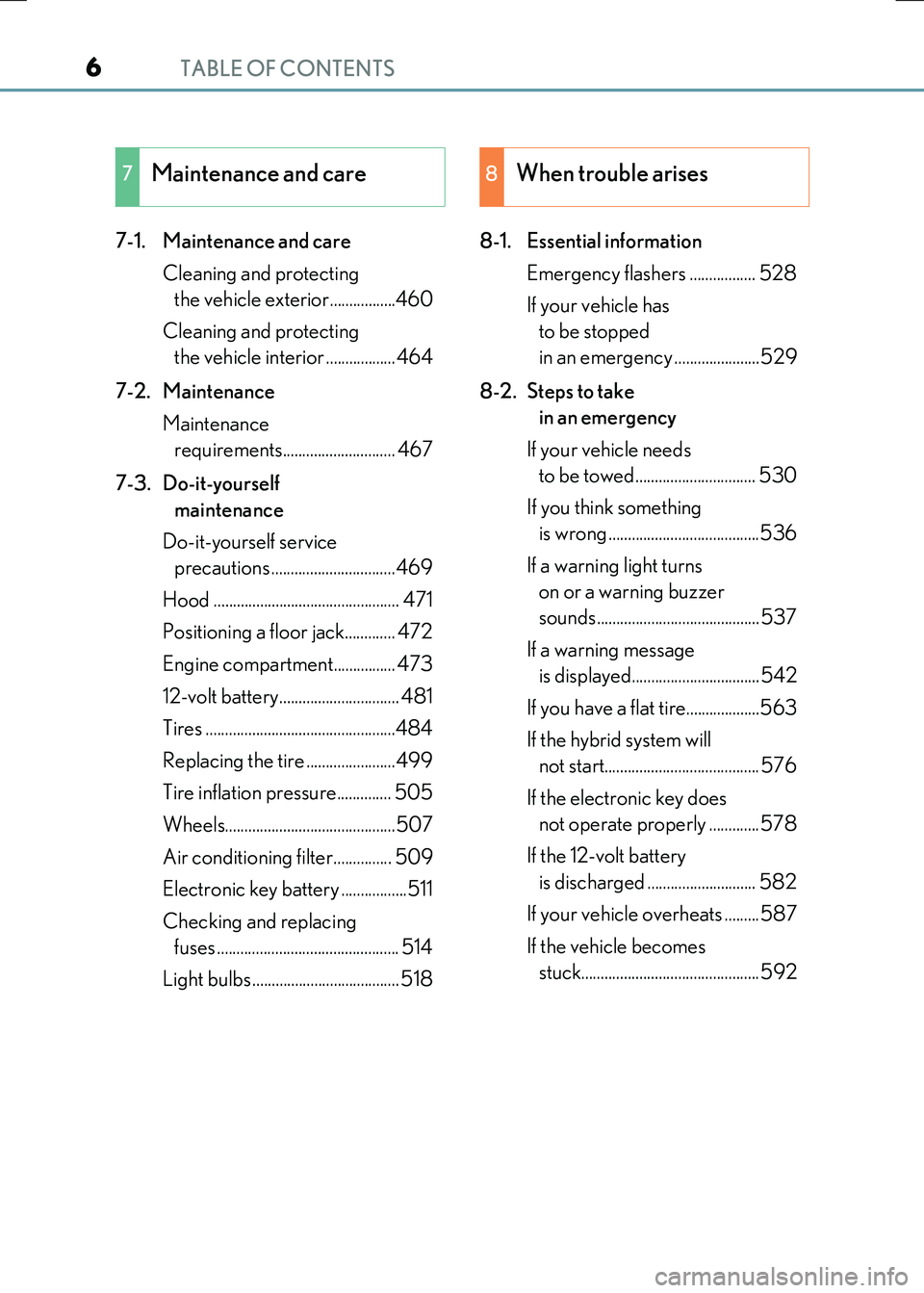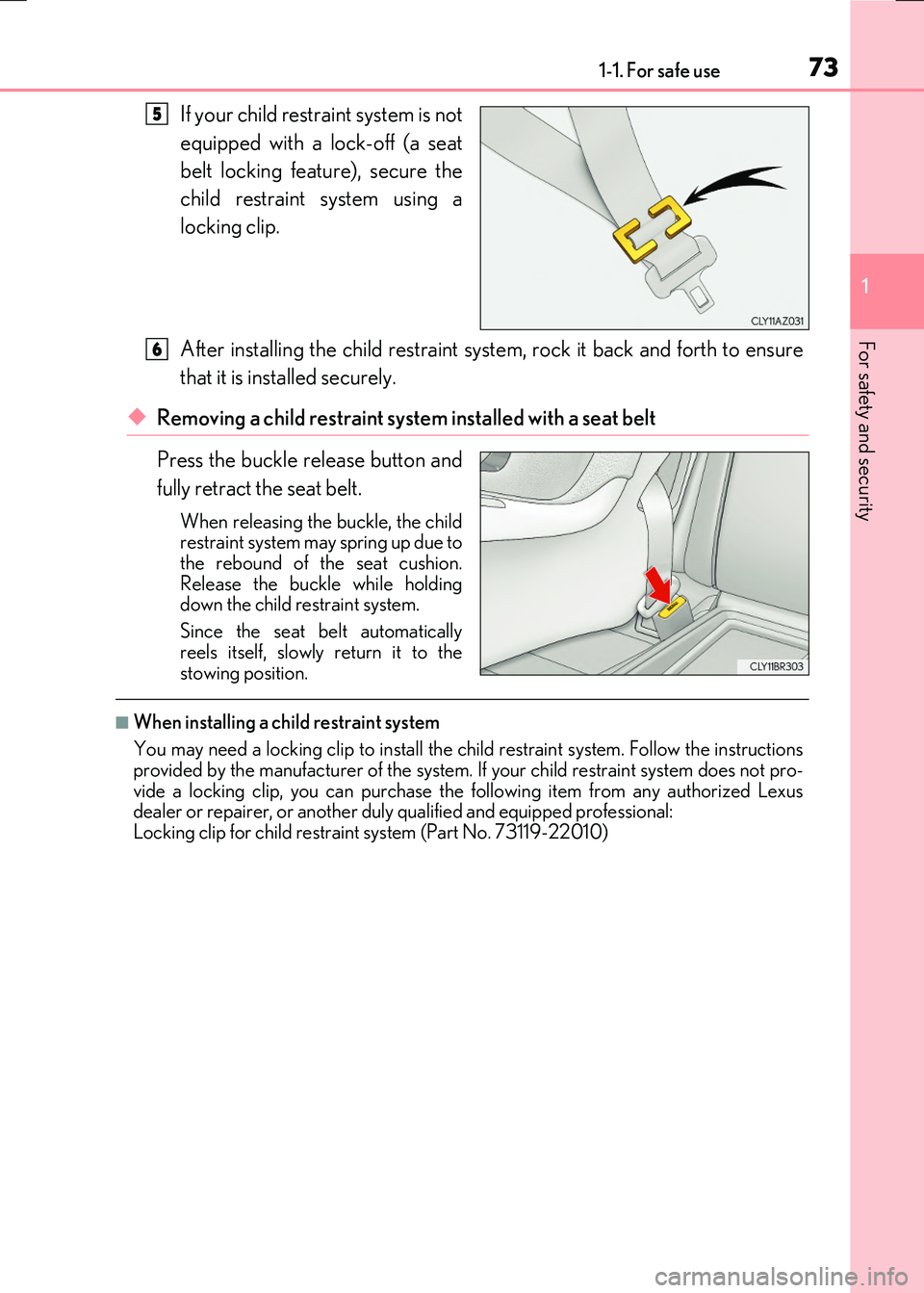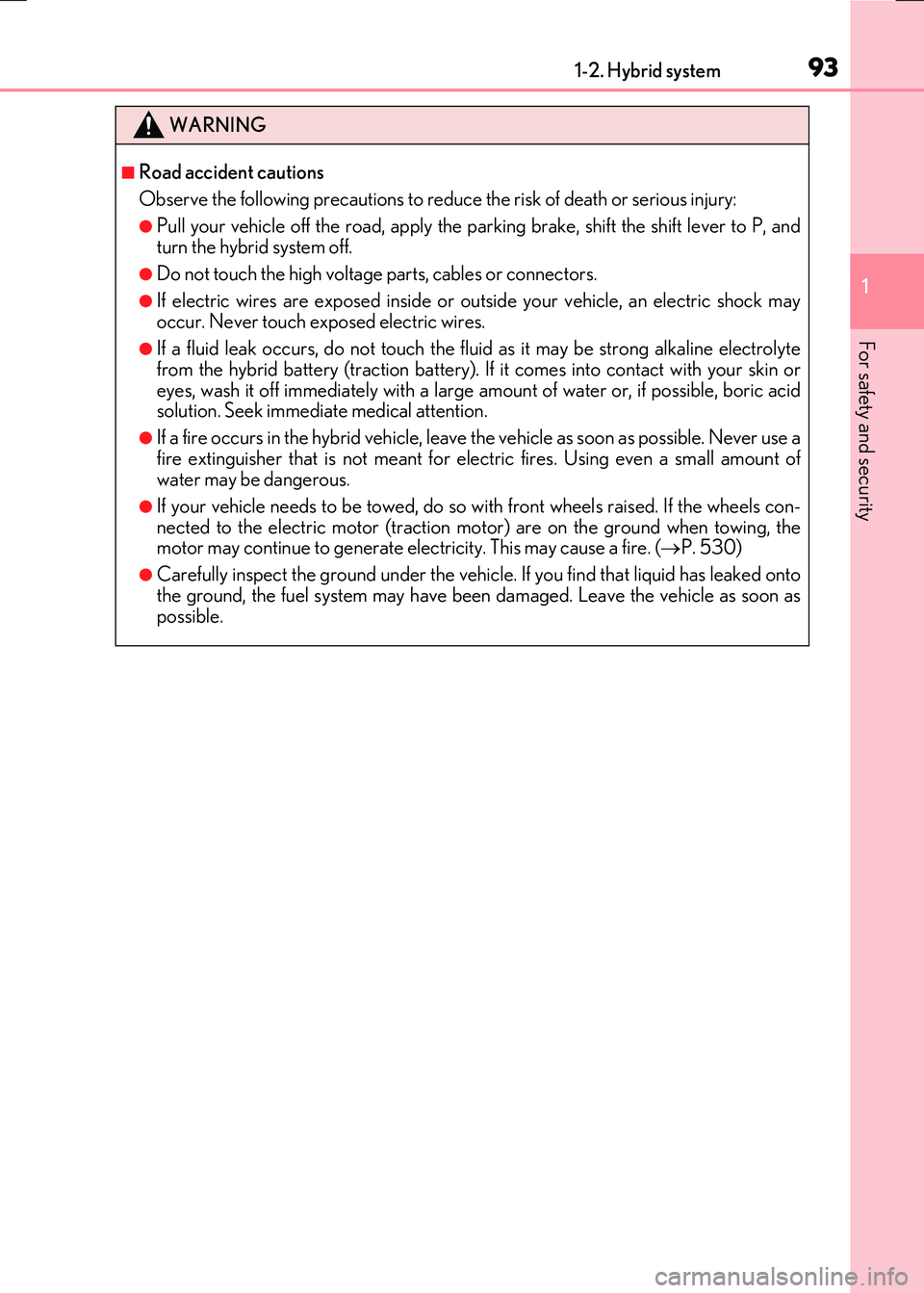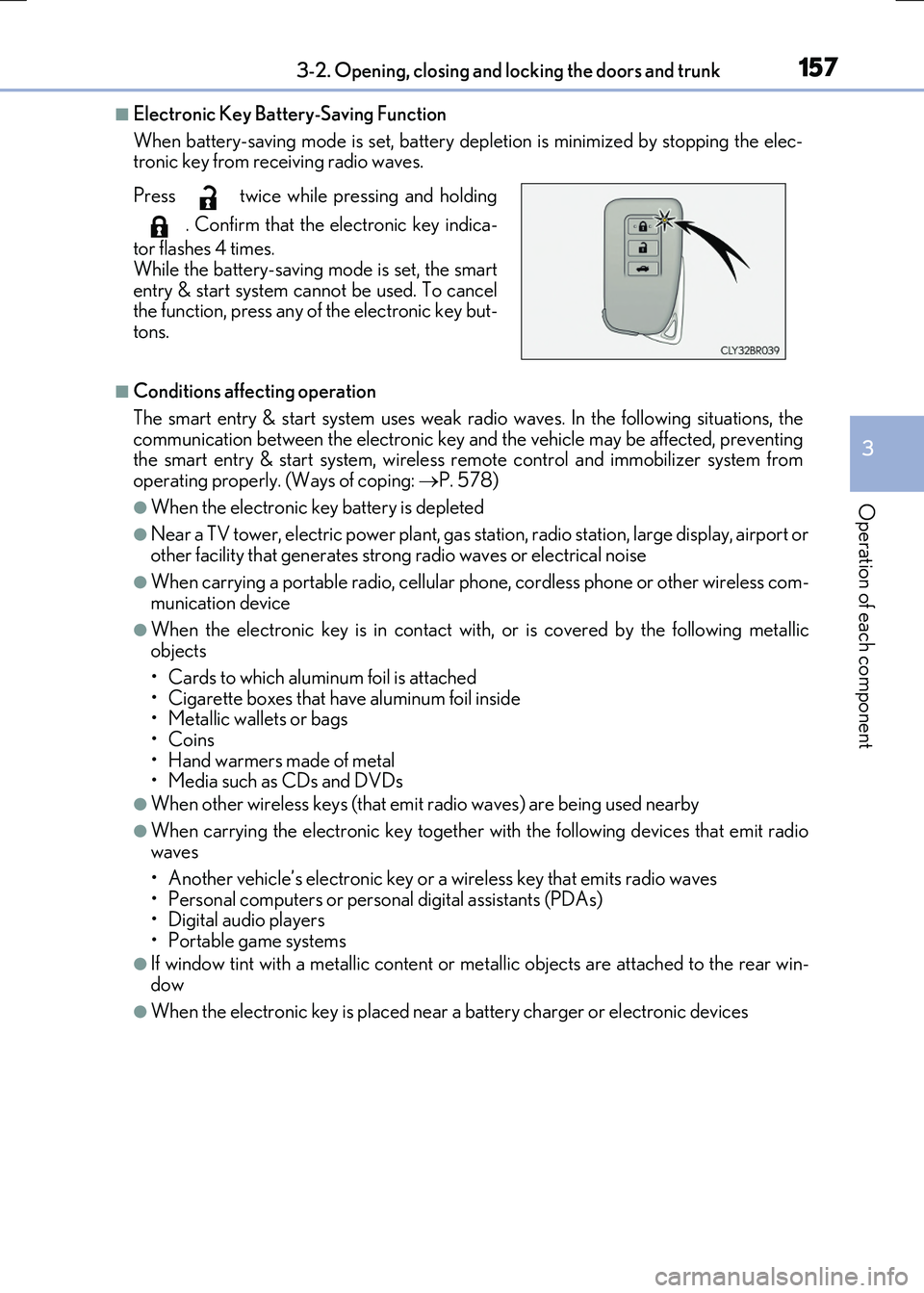tow LEXUS RC300H 2017 Owners Manual
[x] Cancel search | Manufacturer: LEXUS, Model Year: 2017, Model line: RC300H, Model: LEXUS RC300H 2017Pages: 640, PDF Size: 35.53 MB
Page 3 of 640

3
1
9
8
7
6
4
3
2
RC300h_EE(OM24740E)
5
3-5. Opening, closing the windows
and moon roof
Power windows............................ 196
Moon roof .................................... 200
4-1. Before driving
Driving the vehicle .....................206
Cargo and luggage .................... 213
Trailer towing ................................ 214
4-2. Driving procedures
Power (ignition) switch ............. 215
EV drive mode ............................220
Hybrid transmission .................. 222
Turn signal lever ......................... 229
Parking brake ..............................230
ASC
(Active Sound Control)......... 231
4-3. Operating the lights and
wipers
Headlight switch ......................... 232
Automatic High Beam .............235
Fog light switch ...........................239
Windshield wipers and
washer........................................... 241
4-4. Refueling
Opening the fuel tank cap...... 249
4-5. Using the driving support
systems
Cruise control .............................253
Dynamic radar cruise
control.......................................... 257
LDA
(Lane Departure Alert) ........ 273
Lexus parking
assist-sensor.............................. 279
Lexus parking
assist monitor ............................286
Driving mode select
switch ............................................ 301
Driving assist systems...............304
PCS (Pre-Crash Safety
system)............................................311
BSM
(Blind Spot Monitor)............... 319
• BSM function .........................325
• RCTA function ......................329
4-6. Driving tips
Hybrid vehicle driving
tips .................................................334
Winter driving tips ..................... 337
4Driving
Page 6 of 640

TABLE OF CONTENTS6
RC300h_EE(OM24740E)
7-1. Maintenance and care
Cleaning and protecting
the vehicle exterior.................460
Cleaning and protecting
the vehicle interior ..................464
7-2. Maintenance
Maintenance
requirements............................. 467
7-3. Do-it-yourself
maintenance
Do-it-yourself service
precautions ................................469
Hood ................................................ 471
Positioning a floor jack............. 472
Engine compartment................ 473
12-volt battery............................... 481
Tires .................................................484
Replacing the tire .......................499
Tire inflation pressure.............. 505
Wheels............................................507
Air conditioning filter............... 509
Electronic key battery .................511
Checking and replacing
fuses ............................................... 514
Light bulbs ...................................... 518
8-1. Essential information
Emergency flashers ................. 528
If your vehicle has
to be stopped
in an emergency ......................529
8-2. Steps to take
in an emergency
If your vehicle needs
to be towed............................... 530
If you think something
is wrong .......................................536
If a warning light turns
on or a warning buzzer
sounds.......................................... 537
If a warning message
is displayed.................................542
If you have a flat tire...................563
If the hybrid system will
not start........................................ 576
If the electronic key does
not operate properly .............578
If the 12-volt battery
is discharged ............................ 582
If your vehicle overheats .........587
If the vehicle becomes
stuck..............................................592
7Maintenance and care8When trouble arises
Page 16 of 640

16Pictorial index
RC300h_EE(OM24740E)
■Instrument panel (left-hand drive vehicles)
Power switch . . . . . . . . . . . . . . . . . . . . . . . . . . . . . . . . . . . . . . . . . . . . . . . . . . . . . . . . P. 215
Starting the hybrid system/changing the mode . . . . . . . . . . . . . . . . . . . . . . . . . P. 215
Emergency stop of the hybrid system . . . . . . . . . . . . . . . . . . . . . . . . . . . . . . . . . . P. 529 When the hybrid system will not start . . . . . . . . . . . . . . . . . . . . . . . . . . . . . . . . . . P. 576Warning messages . . . . . . . . . . . . . . . . . . . . . . . . . . . . . . . . . . . . . . . . . . . . . . . . . . . . P. 558
Shift lever . . . . . . . . . . . . . . . . . . . . . . . . . . . . . . . . . . . . . . . . . . . . . . . . . . . . . . . . . . . . P. 222
Changing the shift position . . . . . . . . . . . . . . . . . . . . . . . . . . . . . . . . . . . . . . . . . . . . .P. 222
Precautions against towing . . . . . . . . . . . . . . . . . . . . . . . . . . . . . . . . . . . . . . . . . . . . P. 530 When the shift lever does not move. . . . . . . . . . . . . . . . . . . . . . . . . . . . . . . . . . . . .P. 227
Meters . . . . . . . . . . . . . . . . . . . . . . . . . . . . . . . . . . . . . . . . . . . . . . . . . . . . . . . . . . . . . . . . P. 115
Reading the meters/adjusting the instrument panel lights . . . . . . . . . . . . . . . . P. 115 Warning lights/indicator lights. . . . . . . . . . . . . . . . . . . . . . . . . . . . . . . . . . . . . . . . . . . P. 110When the warning lights come on . . . . . . . . . . . . . . . . . . . . . . . . . . . . . . . . . . . . . P. 537
1
2
3
Page 24 of 640

24Pictorial index
RC300h_EE(OM24740E)
■Instrument panel (right-hand drive vehicles)
Power switch . . . . . . . . . . . . . . . . . . . . . . . . . . . . . . . . . . . . . . . . . . . . . . . . . . . . . . . . P. 215
Starting the hybrid system/changing the mode . . . . . . . . . . . . . . . . . . . . . . . . . P. 215
Emergency stop of the hybrid system . . . . . . . . . . . . . . . . . . . . . . . . . . . . . . . . . . P. 529 When the hybrid system will not start . . . . . . . . . . . . . . . . . . . . . . . . . . . . . . . . . . P. 576Warning messages . . . . . . . . . . . . . . . . . . . . . . . . . . . . . . . . . . . . . . . . . . . . . . . . . . . . P. 558
Shift lever . . . . . . . . . . . . . . . . . . . . . . . . . . . . . . . . . . . . . . . . . . . . . . . . . . . . . . . . . . . . P. 222
Changing the shift position . . . . . . . . . . . . . . . . . . . . . . . . . . . . . . . . . . . . . . . . . . . . .P. 222
Precautions against towing . . . . . . . . . . . . . . . . . . . . . . . . . . . . . . . . . . . . . . . . . . . . P. 530 When the shift lever does not move. . . . . . . . . . . . . . . . . . . . . . . . . . . . . . . . . . . . .P. 227
Meters . . . . . . . . . . . . . . . . . . . . . . . . . . . . . . . . . . . . . . . . . . . . . . . . . . . . . . . . . . . . . . . . P. 115
Reading the meters/adjusting the instrument panel lights . . . . . . . . . . . . . . . . P. 115 Warning lights/indicator lights. . . . . . . . . . . . . . . . . . . . . . . . . . . . . . . . . . . . . . . . . . . P. 110When the warning lights come on . . . . . . . . . . . . . . . . . . . . . . . . . . . . . . . . . . . . . P. 537
1
2
3
Page 45 of 640

451-1. For safe use
1
For safety and security
RC300h_EE(OM24740E)
The main SRS airbag system and Pop Up Hood components are shown above.
The SRS airbag system and Pop Up Hood are controlled by the airbag sensor
assembly. As the airbags deploy, a chemical reaction in the inflators quickly fills
the airbags with non-toxic gas to help restrain the motion of the occupants.
When the Pop Up Hood is activated, a non-toxic gas is released due to a chemi-
cal reaction in the lifters, which causes the pistons to eject quickly and raise the
rear portion of the hood. (Pop Up Hood: P. 56)
WARNING
■SRS airbag precautions
Observe the following precaution s regarding the SRS airbags. Failure to do so may cause death or serious injury.
●The driver and all passengers in the vehicle must wear their seat belts properly.The SRS airbags are supplemental devices to be used with the seat belts.
●The SRS driver airbag deploys with considerable force, and can cause death or seri-
ous injury especially if the driv er is very close to the airbag.
Since the risk zone for the driver’s airbag is the first 50 - 75 mm (2 - 3 in.) of inflation, placing yourself 250 mm (10 in.) from your driver airbag provides you with a clear
margin of safety. This distance is measured from the center of the steering wheel to your breastbone. If you sit less than 250 mm (10 in.) away now, you can change yourdriving position in several ways:
• Move your seat to the rear as far as you can while still reaching the pedals com- fortably.• Slightly recline the back of the seat.
Although vehicle designs vary, many drivers can achieve the 250 mm (10 in.) dis- tance, even with the driver seat all the way forward, simply by reclining the back ofthe seat somewhat. If reclining the back of your seat makes it hard to see the road,
raise yourself by using a firm, non-slippery cushion, or raise the seat if your vehicle has that feature.• If your steering wheel is adjustable, tilt it downward. This points the airbag toward
your chest instead of your head and neck. The seat should be adjusted as recommend ed above, while still maintaining control of the foot pedals, steering wheel, and your view of the instrument panel controls.
Page 47 of 640

471-1. For safe use
1
For safety and security
RC300h_EE(OM24740E)
WARNING
■SRS airbag precautions
●Do not hang coat hangers or hard objects on the coat hooks. All of these items could become projectiles and may cause death or serious injury, should the SRS curtain
shield airbags deploy.
●If a vinyl cover is put on the area where the SRS knee airbag will deploy, be sure to remove it.
●Do not use seat accessories which cover the parts where the SRS side airbags inflateas they may interfere with inflation of th e airbags. Such accessories may prevent the side airbags from activating correctly, disable the system or cause the side airbags to
inflate accidentally, resulting in death or serious injury.
●Do not allow anyone to kneel on the passen-
ger seats toward the door or put their head or hands outside the vehicle.
●Do not attach anything to or lean anythingagainst areas such as the dashboard, steeringwheel pad and lower portion of the instru-
ment panel. These items can become projectiles when theSRS driver, front passenger and knee airbags
deploy.
●Do not attach anything to areas such as a door, windshield, side window, front or rear pillar,roof side rail and assist grip. (Except for the
speed limit sticker P. 568)
Page 73 of 640

731-1. For safe use
1
For safety and security
RC300h_EE(OM24740E)
If your child restraint system is not
equipped with a lock-off (a seat
belt locking feature), secure the
child restraint system using a
locking clip.
After installing the child restraint system, rock it back and forth to ensure
that it is installed securely.
◆Removing a child restraint system installed with a seat belt
Press the buckle release button and
fully retract the seat belt.
When releasing the buckle, the child restraint system may spring up due tothe rebound of the seat cushion.
Release the buckle while holding down the child restraint system.
Since the seat belt automatically
reels itself, slowly return it to the stowing position.
■When installing a child restraint system
You may need a locking clip to install the child restraint system. Follow the instructions provided by the manufacturer of the system. If your child restraint system does not pro-
vide a locking clip, you can purchase the following item from any authorized Lexus dealer or repairer, or another duly qualified and equipped professional: Locking clip for child restrain t system (Part No. 73119-22010)
5
6
Page 93 of 640

931-2. Hybrid system
1
For safety and security
RC300h_EE(OM24740E)
WARNING
■Road accident cautions
Observe the following precautions to reduce the risk of death or serious injury:
●Pull your vehicle off the road, apply the parking brake, shift the shift lever to P, and
turn the hybrid system off.
●Do not touch the high voltage parts, cables or connectors.
●If electric wires are exposed inside or ou tside your vehicle, an electric shock may
occur. Never touch exposed electric wires.
●If a fluid leak occurs, do not touch the fluid as it may be strong alkaline electrolyte from the hybrid battery (traction battery). If it comes into contact with your skin or
eyes, wash it off immediately with a large amount of water or, if possible, boric acid solution. Seek immediate medical attention.
●If a fire occurs in the hybrid vehicle, leave the vehicle as soon as possible. Never use a
fire extinguisher that is not meant for electric fires. Using even a small amount of water may be dangerous.
●If your vehicle needs to be towed, do so with front wheels raised. If the wheels con-
nected to the electric motor (traction mot or) are on the ground when towing, the motor may continue to generate electricity. This may cause a fire. ( P. 530)
●Carefully inspect the ground under the vehicle. If you find that liquid has leaked onto
the ground, the fuel system may have been damaged. Leave the vehicle as soon as possible.
Page 105 of 640

1051-3. Theft deterrent system
1
For safety and security
RC300h_EE(OM24740E)
●The intrusion sensor detects intruders or movement in the vehicle.
●The tilt sensor detects changes in vehicle inclination, such as when the vehicle
is towed away.
This system is designed to deter and pr event vehicle theft but does not guarantee
absolute security against all intrusions.
■Setting the intrusion sensor and tilt sensor
The intrusion sensor and tilt sensor will be set automatically when the alarm is
set. ( P. 102)
■Canceling the intrusion sensor and tilt sensor
If you are leaving pets or other moving things inside the vehicle, make sure to
disable the intrusion sensor and tilt sensor before setting the alarm, as they will
respond to movement inside the vehicle.
Turn the power switch off.
Press the intrusion sensor and tilt
sensor cancel switch.
Press the switch again to re-enable the intrusion sensor and tilt sensor.
Each time the intrusion sensor is canceled/set, a message will beshown on the multi-information dis-
play in the instrument cluster.
Intrusion sensor (if equipped) /Intrusion sensor and tilt sensor (if
equipped)
1
2
Page 157 of 640

1573-2. Opening, closing and locking the doors and trunk
3
Operation of each component
RC300h_EE(OM24740E)
■Electronic Key Battery-Saving Function
When battery-saving mode is set, battery depl etion is minimized by stopping the elec- tronic key from receiving radio waves.
■Conditions affecting operation
The smart entry & start system uses weak ra dio waves. In the following situations, the communication between the electronic key an d the vehicle may be affected, preventing the smart entry & start system, wireless remote control and immobilizer system from
operating properly. (Ways of coping: P. 578)
●When the electronic key battery is depleted
●Near a TV tower, electric power plant, gas station, radio station, large display, airport or
other facility that gene rates strong radio waves or electrical noise
●When carrying a portable radio, cellular phone, cordless phone or other wireless com- munication device
●When the electronic key is in contact wi th, or is covered by the following metallic objects
• Cards to which aluminum foil is attached
• Cigarette boxes that have aluminum foil inside • Metallic wallets or bags•Coins
• Hand warmers made of metal • Media such as CDs and DVDs
●When other wireless keys (that emit radio waves) are being used nearby
●When carrying the electronic key together with the following devices that emit radiowaves
• Another vehicle’s electronic key or a wireless key that emits radio waves • Personal computers or personal digital assistants (PDAs)• Digital audio players
• Portable game systems
●If window tint with a metallic content or me tallic objects are attached to the rear win-
dow
●When the electronic key is placed near a battery charger or electronic devices
Press twice while pressing and holding
. Confirm that the electronic key indica-
tor flashes 4 times.
While the battery-saving mode is set, the smart entry & start system cannot be used. To cancelthe function, press any of the electronic key but-
tons.